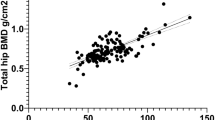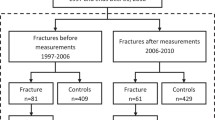Abstract:
Measurements of bone mineral density (BMD) are useful for the assessment of fracture risk in osteoporosis. First prospective studies showed that quantitative ultrasound as measured at the calcaneus also predicts future hip fracture risk, independently of BMD and as accurately as BMD. The aim of this study was to compile a reference population for a new ultrasound device that determines amplitude-dependent speed of sound (AD-SOS) through the proximal phalanges of the hand and to prove its ability to distinguish between health volunteers and osteoporotic patients. In a case–control study we examined 139 healthy women aged 21–94 years and a group of 24 female patients aged 69–94 years with recent hip fractures. In the healthy reference population additional BMD measurements were performed with dual-energy X-ray absorptiometry (DXA) and quantitative ultrasound measurements at the calcaneus were carried out. In vivo precision of AD-SOS measurements through the phalanges was 0.52% CV. Simple regression analyses showed a negative correlation with age (r= 70.73, p50.001); modest significant correlations with BMD of the lumbar spine (r= 0.36, p50.001) and BMD of the femoral neck (r= 0.37, p= 0.002) as measured with DXA were shown. The comparison with another ultrasound device measuring SOS and broadband ultrasound attenuation (BUA) through the calcaneus showed correlation with SOS (r= 0.50, p50.001); no significant correlation was found with BUA measurements. Furthermore a dependency of AD-SOS values in anthropometric factors such as body mass index (r= 0.37, p50.001), height (r= 0.40, p50.001) and weight (r= 0.23, p50.05) was shown. First study results on 24 clinically diagnosed osteoporotic patients, defined as patients with recent (51 week) pertrochanteric or femoral neck fractures, showed a good separation between age- and sex-matched controls and osteoporotic patients (Z= 72.0 SD). Receiver operating characteristic (ROC) curves showed an area under the fitted curve of 0.83 + 0.06. These results are powerful for a device measuring AD-SOS through the proximal phalanges of the hand, and further prospective studies have proven the capability of phalangeal ultrasound in fracture risk assessment.
Similar content being viewed by others
Author information
Authors and Affiliations
Additional information
Received: 4 January 1996 / Accepted: 15 January 1998
Rights and permissions
About this article
Cite this article
Alenfeld, F., Wüster, C., Funck, C. et al. Ultrasound Measurements at the Proximal Phalanges in Healthy Women and Patients with Hip Fractures. Osteoporos Int 8, 393–398 (1998). https://doi.org/10.1007/s001980050081
Issue Date:
DOI: https://doi.org/10.1007/s001980050081




